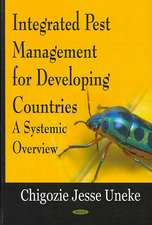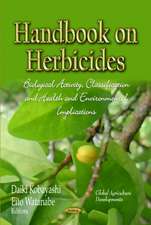Green Trends in Insect Control: RSC Green Chemistry Books, cartea 11
Editat de Oscar Lopez, Jose G. Fernandez-Bolanosen Limba Engleză Hardback – 31 mai 2011
This book presents the current approaches for insect pest control as a "green" alternative to classical and more toxaic agrochemicals. An overview of the recent advances in insecticide chemistry is also included, which will be of interest to a vast group of researchers - agrochemists, biochemists, chemists and toxicologists. The combination of both chemical and toxicological aspects of insecticides is unique and the book includes contributions from synthetic chemists, entomologists, environmentalists and toxicologists giving it wide appeal. Throughout the book, the different approaches that involve "greener chemicals" are emphasized. The book is divided into 9 chapters, each considering the state of art of each family of insecticides, together with future expectations. Each chapter gives a description of useful biorational insecticides, highlighting environmentally-friendly processes and then the mode of action is fully-described, emphasizing selectivity towards targeted species. Finally, for every family of compounds, their environmental effects (toxicity, bioaccumulation and metabolism) is considered, comparing them to classical insecticides, including human and environmental risk assessments. In addition the formulation, dispersal and persistence in the environment are covered as key aspects in developing greener agrochemicals. The book also includes a general introduction to entomology, with special emphasis on those insects that act as vectors in the spread of diseases. Insects that may be potential pests against humans and livestock are included, focusing on their life cycles, and physiology, as a logical comprehension of mode of action of insecticides. In addition there is a chapter on classical insecticides (covering both, approaches prior to the chemical era, and classical chemical insecticides, organochlorinated, organophosphorus, and carbamates) for comparison with current trends in pest control. The negative environmental effects that such insecticides have caused in nature, such as poisonings, bioaccumulation or toxic effects are highlighted. It is hoped that the use of more specific agrochemicals and approaches may avoid, or at least considerably reduce such severe and irreversible effects in nature. The insecticides covered are considered from numerous points of views: chemistry, toxicological profile, risk assessment, legal status, environmental behaviour and selectivity. The most important families of currently used insecticides are covered and critical discussions about future perspectives are included with frequent comparisons to classical insecticides. The following topics are covered in the book, as greener alternatives to classical insecticides: " Pyrethrins and pyrethroids " Neonicotinoids " Spynosins " Insect growth regulators " Botanical insecticides " Microbial insecticides " Integrated Pest Management Programs (IPM)
Preț: 1032.78 lei
Preț vechi: 1200.91 lei
-14% Nou
Puncte Express: 1549
Preț estimativ în valută:
197.65€ • 205.58$ • 163.17£
197.65€ • 205.58$ • 163.17£
Carte tipărită la comandă
Livrare economică 14-28 aprilie
Preluare comenzi: 021 569.72.76
Specificații
ISBN-13: 9781849731492
ISBN-10: 1849731497
Pagini: 353
Dimensiuni: 161 x 240 x 26 mm
Greutate: 0.69 kg
Editura: Royal Society Of Chemistry
Seriile RSC Green Chemistry, RSC Green Chemistry Books
ISBN-10: 1849731497
Pagini: 353
Dimensiuni: 161 x 240 x 26 mm
Greutate: 0.69 kg
Editura: Royal Society Of Chemistry
Seriile RSC Green Chemistry, RSC Green Chemistry Books
Cuprins
1. Main topics in entomology. Insects as diseases vectors (tentative title) 2. Classical insecticides: past, present and future 3. Pyrethrins and Pyrethroid Insecticides 4. Basic and applied aspects of neonicotinoid insecticides 5.The spinosyns (tentative title) 6. The Diacylhydrazine Insecticides 7. Needles in the haystack: Exploring chemical diversity of botanical insecticides 8.Towards a healthy control of insect pests: Potential use of Microbial Insecticides 9. The Challenge of Green in a Pesticide-Dominant IPM World
Notă biografică
Dr Óscar López received his PhD at Seville University in 2003 under the direction of Professor José G Fernández-Bolaños, José Fuentes and Inés Maya. In March 2004, he was appointed as lecturer in Environmental Organic Chemistry at the University of Huelva, Spain. In June 2004, he was appointed as lecturer in Organic Chemistry at the University of Seville, Spain, in the Faculty of Chemistry. He spent 16 months (2005-2006) in a postdoctoral stay in Aarhus University, Denmark under the direction of Professor Mikael Bols working on the design of glycosidase inhibitors and the preparation of cyclodextrin derivatives as artificial enzymes. In 2009 he got a position as an Associate Professor in the Organic Chemistry Department, University of Seville, Spain. His research interests include Carbohydrate Chemistry, Heterocyclic Chemistry, Green Chemistry, Organoselenium Chemistry, Cyclodextrins and Supramolecular Chemistry, Glycosidase Inhibitors and Antioxidants. Professor José G Fernández-Bolaños completed his PhD at Seville University in 1984, after working on the synthesis of C-nucleoside of imidazol, under the direction of Professor José Fernández-Bolaños, his father, and Professor José Fuentes. He spent one year in a postdoctoral stay at the Technical University of Denmark, Lyngby, working on the synthesis and conformational analysis of sterically hindered oligosaccharides, under the direction of Professor Klaus Bock. He got a position as Professor at Seville University in 1987, and is currently a Professor of Organic Chemistry. His research interests include Carbohydrate Chemistry, Heterocyclic Chemistry, Green Chemistry, Organoselenium Chemistry, Cyclodextrins, Antioxidants from natural sources and Alkaloid Insecticides.
Textul de pe ultima copertă
Green Trends in Insect Control presents the current approaches for insect pest control as a "green" alternative to classical and more toxic agrochemicals. An overview of the recent advances in insecticide chemistry is also included, which will be of interest to a vast group of researchers - agrochemists, biochemists, chemists and toxicologists. The combination of both chemical and toxicological aspects of insecticides is unique and the book includes contributions from synthetic chemists, entomologists, environmentalists and toxicologists giving it wide appeal. Throughout the book, the different approaches that involve "greener chemicals" are emphasized. The book is divided into nine chapters, each considering the state-of-the-art of each family of insecticides, together with future expectations. Each chapter gives a description of useful biorational insecticides, highlighting environmentally-friendly processes and then the mode of action is fully-described, emphasizing selectivity towards targeted species. Finally, for every family of compounds, their environmental effects (toxicity, bioaccumulation and metabolism) is considered, comparing them to classical insecticides, including human and environmental risk assessments. The book also includes a general introduction to entomology, with special emphasis on those insects which act as vectors in the spread of diseases. Insects that may be potential pests against humans and livestock are included, focusing on their life cycles, and physiology. In addition there is a chapter on classical insecticides for comparison with current trends in pest control.
Descriere
This book presents the new families of insecticides developed recently as a "green" alternative to classical and more toxic agrochemicals.




















